The US Department of State has approved a request by the United Kingdom to purchase 50 upgrade kits for the Phalanx Close-in Weapon System, the Defense Security Cooperation agency said in a press release on Thursday.
The Defense Department explained that the proposed sale also includes support equipment, test equipment, spare parts, technical documentation, training and engineering technical assistance. The notice of the proposed sale reads:
“The Government of the United Kingdom (UK) has requested to buy fifty (50) MK 15 Phalanx Close-in Weapon System (CIWS) Block IB Baseline 2 Upgrade Kits. Also included are support equipment, test equipment, initial spare parts, technical documentation, training, and engineering technical assistance, and other related elements of logistics and program support. The total estimated program cost is $75 million.
This proposed sale will support U.S. foreign policy and national security objectives of the United States by improving the security of a NATO ally which has been, and continues to be, an important partner on critical foreign policy and defense issues.
The proposed sale of the Phalanx Baseline 2 Radar Upgrade Kits will be used for close-in ship self-defense against air and surface threats onboard the UK’s naval combatants and auxiliaries. The UK, which already has earlier versions of the MK 15 Phalanx in its inventory, will have no difficulty absorbing these upgrades and support into its armed forces.”
The Phalanx weapon system is a rapid-fire, computer-controlled, radar-guided machine gun that can defeat anti-ship missiles and other close-in threats that have penetrated other lines of defence, according to the manufacturer Raytheon.


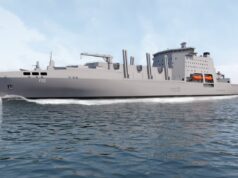

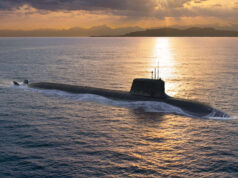
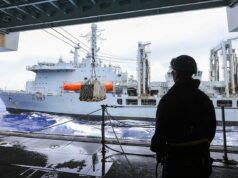
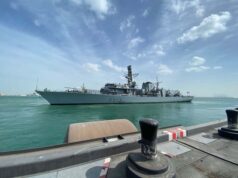
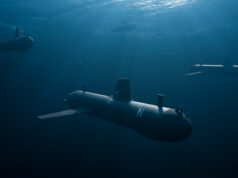



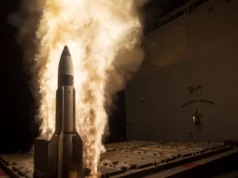

I have no idea how militarily effective this kit is but it certainly looks like it does the business when it’s firing a wall of bullets into the air.
Are these ever used against ground targets as they could certainly ruin the day of anything smaller than a main battle tank.
Peter wrote:
Are these ever used against ground targets as they could certainly ruin the day of anything smaller than a main battle tank.
The only land use CIWS have been used for until now ( That I know of) is Counter Rocket, Artillery, and Mortar (CRAM)
https://www.youtube.com/watch?v=O7rc7U61B5E
At Basra against incoming rockets I think??
Daniele wrote:
“At Basra against incoming rockets I think??
Here’s one that DJ made earlier…
https://ukdefencejournal.org.uk/3604-2/
Ahhh thank you farouk.
Before my time here I think.
They where at Bastion as well .
It did annoy some very senior Army NCOs that laid back , chilled out RN Chief Tiff’s did not have the correct military bearing for doing the maintainer/operators job in theater.
The only problem with Phalanx is the calibre of the gun as 20mm doesn’t allow for the fitting of more exotic fuses as in say a 30mm or 35mm or larger.
It doesn’t have fuses. it has a kinetic penetrator.
Oh FFS I have know a site where people read what they want to read to score f*cking points.
Right let’s have a look at what I said shall we?
The only problem with Phalanx – this indicates that perhaps Phlanax is good but it has problem
is the calibre of the gun – this specifies the area where the problem (might be found)
as 20mm doesn’t allow for the fitting FOR THE FITTING OF ….FUSES……..
I have done with this place.
David – a bit OTT, perhaps ?
(Chris H) David – close the door on your way out.
Wow….?
Actually you said ‘for the fitting of more exotic fuses’, clearly implying the existence of standard fuses.
No need for the nastiness after a helpful correction don’t you think?
??
My reading of it is that you implied that Phalanx had a 20mm round fitted with a fuse.
My answer is that it doesn’t…it has a Kinetic Penetrator.
If you are saying that firing an AHEAD type round would be an advantage then yes it probably would but in my experience only standard cannons get AHEAD rounds…fitting a round programmer to rotating barrels on a gatling gun is not feasible.
Just saying…
Hi Peter the F35B carries this gun I believe
Nope. Most earlier American jets use the M61 Vulcan used on the Phalanx, but the F-35s will be carrying 25mm cannons either built in or in optional gun pods
(Chris H) Callum – ..and as we speak courtesy of a certain Twitter feed:
https://twitter.com/cencio4/status/1043172250336120833
Chris H, Will this compromise the F35’s stealth capabilities? or has this been fitted purely for the purpose of testing the gun?
(Chris H) Nigel – I am no expert but given wing pylon loaded weapons / fuel tanks tend to negate any radar advantage I am guessing that a big gun pod will do the same. It will certainly be heavy and add drag. It is worrying it has to be externally mounted on the F-35B and F-35C although the Harrier carried two cannons in external underslung pods but Typhoon has a big Mauser BK27 27mm calibre cannon embedded in the Starboard wing root
http://www.b-domke.de/AviationImages/Typhoon/Images/Typhoon_ZJ924_12462.jpg
Having said that I know F-35As have their The GAU-22/A cannon in an embedded pod on the Port upper wing
Thank you!
Managed to find this.
http://www.thedrive.com/the-war-zone/8124/check-out-this-pic-of-an-f-35b-firing-its-gun-pod-in-the-air-for-the-first-time?
Used at Basra air base in the Gulf war, taken from our ships. Google it, turns out they were very effective in that scenario.
Hopefully this is just an order to cover the current fleet rather than the fleet post ~2025. Between the Type 45, Type 26, Albion, and Queen Elizabeth classes, a total of 34 Phalanx units are accounted for. If you fit a unit to each of the Type 31e class that leaves a total of 9 units remaining. Those units then need to be spread between all the (amazingly high value and mission critical) ships of the RFA. In practical terms, without more units the Naval Service will have to swap out Phalanx units between ships at refit in order to keep the units going forward full equipped. It’s not the end of the world, but it complicates the logistics of keeping the fleet in a fit state to fight.
Actually I got my numbers slightly wrong: the Type 45, Type 26, Albion, and Queen Elizabeth classes between them acount for 38 units. So once you’ve armed the Type 31e, there are only 7 Phalanx units left over.
Does that include ships in de-refit?
Too few. Given the relatively cheap cost and importance of CIWS compared to the billions spent then tens of millions more should be added to ensure the Bays, the Tides, the Forts, Argus, should all be equipped as standard.
No FFBNW.
Indeed.
The current frigate fleet doesn’t use Phalanx, but future ships will. The current inventory is enough to cover all ships in both the RN and RFA fitted to receive it, but we shouldn’t reduce this capability with the frigates. Purchase new units for them.
Edit: I’ve heard various sources for how many Phalanx units the UK currently has. Anything from 41-48. Even so, additional units are needed – they’re cheap for the protection they provide.
A bit like dedicated AEW helicopters (and additional ASW, Junglies)…
Will the QE Class get this system? As yet I can’t see one on QE, though she is not fully commissioned so their fit must be planned before that date?
Yes, each carrier will have three units, alongside four 30mm cannons. Neither are fitted as of yet.
So our QE’s will have 20mm Phalanx, 25mm on the F35’s and 30mm DS30B guns. Many other ships also have 30mm plus 114 (with new ones having 76 or 127), our Typhoons have 27mm, our new Scout IFV will carry 40mm and our Apaches have the short 30mm. The RA also have 105 and 155 and the infantry have 9mm, 5.56, 7.62, 8.58 and 12.7mm.
Isn’t that too many types? Could we standardise on say 127mm for RN and RA, have 40mm cannon for CIWS and smaller ships and IFVs, and have 25mm for Apache, F35 and Typhoon?
About $1.5m per kit. Presumably fitting and testing the upgrade will be extra. What does a brand new mount cost – $6m?
The order seems to cover every Phalanx system in the UK’s inventory, and implies that all are now at the Block 1B standard – which wasn’t previously clear. I wonder if anything remains of the original Block 0’s hurriedly purchased for HMS Illustrious back in 1982!
RFA’s only get Phalanx if deploying to a region with at least a moderate threat level. If you assume about a third of the surface warships are also non-operational (1 QEC, 1 Albion, 2 T45’s, etc) and without Phalanx, then 50 mounts should be enough – even allowing for a few being used for training purposes or otherwise unavailable. The bolt-on portability of Phalanx is one reason why it survives in the RN, long after the fixed Goalkeeper system has gone.
RN Goalkeeper was tied in to the Dutch Navy using Spey GTs on their ships.
As we have now removed Goalkeeper from our ships I guess that the Speys are off the Dutch vessels.
Pity, because I have worked with Phalanx and Goalkeeper and Goalkeeper is a far superior system. However its big, heavy, has deck penetration and is complex compared to Phalanx which are all reasons that where considered when the decision was made for it to be removed.
I wonder whats going to happen to the GAU 8 cannons? They would be a nice addition to a C130 through a side access hole.
Gun busters
Could these not be put on RFA vessels and left there. Seems a waste to me
the goalkeeper system was too heavy
Lets hope they buy spare barrels.
That haunting attack alarm noise, just there to remind you to pull your sleeping bag up over your face for added protection.
BV
Not sure the cost figure in the article is accurate as the US DSCA released this notice as required by US Law governing foreign military sales. They say its worth $137 Mn. But whatever its good to see the MoD updating what we have regardless of if we need more
http://www.dsca.mil/major-arms-sales/united-kingdom-mk-15-phalanx-close-weapon-system-ciws-block-1b-baseline-2
How come we’ve never gone down the route of a combined gun and missile CIWS, i.e. like the Russians with their Kashtan?
I presume it has something to do with the Kashtan being so heavy and presumably needing to penetrate the the ship hull.
Still, especially the Russians seem to fit out their ships with a lot more CIWS, although I don’t now how effective it is.
The US went that route on their carriers and larger amphibs. They actually have a triple layer defense, 2x ESSM 8 missile launchers, 2x RIM 116 missile launcher, 2x phalanx. Surely the RN could afford to at least put a similar defense layer on the QE class. Madness to spend billions of pounds on a single asset yet refuse to spend a few extra million on a real point defense system. A couple of phalanx won’t cut it.
I have discussed this before.
Sticking extra weapons on Aircraft Capable ships adds a whole layer of defense and a whole layer of other issues that compromise ship and aircraft safety.
The issue are such things as FOD and safe fly lanes.
The trials conducted on an LPD proved that the sabot from the CIWS shells would have destroyed any aircraft on deck and severely injured any of the flight deck crew that where hit by the plastic sabot or the aluminium pusher pads.
If you want to add missiles to the mix as well it would make things worse.
Basically different Navies, Different Cap tallies.
I realise that ships have layered defence, but I was wondering why we have never tried to make an actual combined gun/missile system like the Kashtan. Are there pluses to it?
In some respects its not needed and may actually complicate matters depending on how the Kashtan prioritises threats. This is because the Kashtan combines the missiles and guns on the one mounting. There must be a clearly defined point where the guns takes over from the missiles as the guns must be cued on to the target. The missiles which are 9M311, which are a derivative of the SA19 and originally used SACLOS line of sight command guidance. The more modern system uses both radar tacking and guidance being able to engage at least 6 targets. The missile has a relatively slow speed (Mach2) so may have difficulty engaging faster targets. I couldn’t state if they have an off bore sight capability as they are semi-active guided.
For a self contained missile/gun unit they are a good option, but they are massive and at least four times the size of the Phalanx, so on some ships would have to be mounted much lower, which then brings the horizon closer. The guns alone have a much longer engagement range than phalanx. As it uses twin 30mm gatling guns each shell contains more tungsten to engage the target compared to the 20mm Phalanx’s, thereby give a theoretical higher chance of a kill.
The Type 26 will use a combination of SeaCeptor and Phalanx. The SeaCeptor will reach out to the horizon and even beyond and the Phalanx will deal with any leakers. I think a better system would be to keep the SeaCeptor and Phalanx, but back it up with a soft vertical launch short range missile system (0 to 10km) perhaps an evolution of Starstreak. However, the laser guidance would need to be backed up with radar, especially when its lashing down with rain. Both the Satrstreak and SeaCeptor have over a Mach 4 plus engagement speed. So my idea would be a three tiered defence i.e. SeaCeptor, Starstreak then Phalanx.
Not related, but why does south Korea get 6 P-8 for 2 billion dollars and uk pays so much more. Ridiculous we wait 10 years. MOD cull 10,000 pen pushers and invest in what matters.
The details are in the contract. The purchase price you may have seen for the UK could have included training, maintenance, weapons, sensors, spares etc. whereas the South Korean version may have been for just the aircraft.
The detail will be in the contract. The UK cost will be for spares and support over a fixed period. I suspect the the ROK contract does not include spares or support. So if it goes wrong you pay there and then to get it fixed and the cost of the spares there and then.
Simple analogy is a plumber…if you prior book him in or have a pre-existing service plan in place its a lot cheaper than giving him an emergency call out on a Saturday evening…
What did we pay? I thought it was was £2bn for 9 which doesn’t sound too far adrift from $2bn for 6, in fact cheaper, but maybe I’m totally misremembering the UK price. I’d be grateful if someone could correct me as necessary although, as mentioned above, I realise the prices are pretty impossible to decode anyway without knowing exactly what extras beyond the core product are included in the price.
contrary to popular belief, just because an organisation is governement owned does not mean you can remove all the pen pushers, these generally being people like: experts on procurement, planning, decision makers, admin people ect. Unless you feel it would be a good use of uniformed service people’s time to retrain and focus on procurement law etc.
The NHS get the same, this strange belief that you should just have frontline staff, forgetting that how the hell will you pay them, ensure you have the right number of brain surgeons vs OBGs, qualified nurses vs health care assistants, correct number of GP practices, hospitals, mental health units etc, even pay for the heating, water, tv licences etc.
I will tell you a secret, the first thing the Con/lib government did was get rid of a huge number of commissioning ( purchasers, checkers) and strategic planners from the NHS to save a buck. 8 years later they have presided over a health system that can no longer react or adapt and they have been unable to fundamental change how healthcare works in this country (costing a fortune) because they gutted the people who had been the planners and implementors of new ways of working ( otherwise known as pen pushers). The saddest irony now is all the change is again being supported by all the same people but instead they are working for KPMG at three times the cost to the tax payer and with only half the accountability.
Defence, health economies ect are complex systems that damage vast knowledge and expire cce bases to make them work as systems, that means experts in system design, management, change, capability assessment and needs assesement, it can’t be done by Bill and Bob as a second job when they have finished the day job on the front line.
Most of the pen pushers ( I’m an NHS pen pushers by the way) get their system knowledge the hard way.
The NHS (and I work in the frontline and gave proudly done so for 20+ years since demob) should do a simple exercise. Get all the clinical staff who actually put hands on and treat patients to identify the support staff they need to deliver their job. Simple.
That way you would have receptionists, ward clerks, payroll, HR staff, recruitment staff etc but crucially one hell of a lot less managers. Just look at some statistical evidence NHS inpatient beds Vs numbers of managers, flow managers, and none jobs. Beds have gone down, capacity reduced and the answer to the problems seem to be let’s recruit more managers to manage the reduced resource.
The NHS could very very easily reduce management costs by 50% overnight and not impact patient care at all. That should save about £15 billion a year by my reckoning. £15 billion= one heck of a lot more wards, rehabilitation beds, doctors, nurses, physics, pharmacists etc.
I would very happily and merrily do this cull for the NHS and stand ready to deliver £15 billion in savings for the NHS.
(Chris H) For all the purchasing and supply people in the NHS can someone in that service explain why there are huge differences in the price each NHS Trusts pay for the same items used across England and Wales (I will leave Scotland to the SNP)? Indeed why is purchasing still split across individual Trusts? Two examples provided by The Department of Health as far back as 2014 said some trusts pay over 135% more for certain products:
* 2Gether NHS Foundation pays £4.34 for 80mg white paper, Moorfields Eye Hospital pays just £1.84.
* Newcastle Tyne and Wear pays £5.57 for examination gloves, which is 117% more than the Royal Wolverhampton, which pays £2.56.
* On just the limited range of products for which prices have been compared, Guys and St Thomas Trust could save £633,000 annually if it paid the same price as the cheapest 25% of trusts.
Given the size of the NHS, it is the largest employer in Europe and there aren’t huge differences in what each hospital or surgery uses it should be buying everything at rock bottom prices and served from a centralised warehouse and distribution centre. But to do that it would entail private expertise and logistics companies, the Lefties would scream ‘NHS Privatisation’ and the Tories would take fright.
The real issue behind all this is that the NHS has become ‘owned’ by Labour and so is a political minefield and there is therefore no political will to make the changes needed. Personally I would use the Canadian model that delivers more for less cost and is still free at the point of need funded by taxation. But each hospital is privately run. A heresy too far for the UK.
Simply Chris the NHS is not as most people believe a single organisation it is instead a very large number of diverse organisations that have a contract to deliver health services, this allows them to use the NHS logo.
Many of these organisations are statutory in nature and “owned by the state” you will see these described as NHS Foundation trusts, they are each legally and actually a singular state owned organisation, they have a contract to run services, employ their own staff and are financially independent. They tend to be acute ambulance services and acute hospitals ( both district general and specialist regional centres). The reason they are owned by the state is that no private sector organisation has yet had success in finding a business model that can run an acute hospital within the financial envelop set for the NHS by the DOH ( we have tried, but the business in question gave the contract and hospital back stating it was not possible, business was circle a well respected Private hospital organisation, that still provides elective surgery services to the NHS).
Other NHS branded organisations will be either private or third sector organisations with an NHS contract, these will often have the NHS logo with a separate organisation organisation name, they can also be described as “working in partnership with the NHS” if their main activity base is not from NHS contracted work. This includes all GP practices, a large number of community care services, some elective care surgery centres, GP out of hours services, 111 services.
There is a new model of organisation out their now, this a businesses that are created by a number of NHS foundation trusts and other businesses to bring their knowledge together to bid for larger more complex system wide contracts that the NHS is now developing or to provide care at scale ( such as large numbers of GP practices and a local acute hospital creating a business to bid for integrated urgent care contracts.
The next type of organisation is a Clinical commissioning group, this is a statutory organisation run by all the GP practices in a specific area, usually a county (but goes from populations of about 80k to 1 million). This organisation holds the budget for all acute care, mental health, children’s services, community care ect and buys all this from diverse businesses on behalf of the population, it also assesses what’s needed, plans for future need, holds contract providers to acount for activity and quality of care.
You then have the county council, these run ( or sometimes buy in) all public health activity, thus includes, health visitors, school nursing services and health education.
finally NHS England, commission ( hold the contracts for )all GP practices and hold the CCGs to account for what they do.
So the simple answer is the NHS is not “an organisation” its hundreds and hundreds of independ businesses ( some state owned some not) who all happen to have a contract with the U.K. Governement to provide the population with healthcare. It’s sort of like all the different food producers who supply tesco, they all have to buy and negotiate their own purchasing based on quanity used and time length of relationship, just cus they have a contract with tesco they can’t all negotiate the same supplies.
Not saying it’s clever, every government makes it worse, as they cut the NHS into smaller segments tying to temp the private sector to take more and more. Which they have to do as a lot of NHS activity is just to high risk for the private sector unless you are willing to pay around twice/three times the standar NHS tariffs.
Simple answer is it’s just the NHS as most people believe it to be ( a monolithic public sector provider of all health needs) has not actually existed for about 35 years, although in truth it never did as GPs, pharmacy, dental and optoms have always been independent businesses.
Mr Bell
I do respect where you are coming from, because I’ve been there and had that view. but the person I am now with my experiences just don’t not agree with you on this.
I Spent most of my clinical time time in cancer wards and then as charge nurse in ED putting people back together( at that point in my professional development I would have agreed with you) , but I,ve worked from kitchen assistant in a big acute, nursing assistant in a elderly mental health nursing home, Childrens hospice as an RN, ED acute nurse and charge nurse , risk manager, clinical trainer, GP practice service developer all the way to a senior manager overseeing the safety of care for a population of 1.5 million people ( I’ve three degrees in health and am two different type of registered clinician , Trained at a high level from trauma life support and clinical stuff to quality improvement, quality management and investigating events why we harmed/killed people) I know from my depth and width of knowledge and experience that we need lot of people looking at the problems and sorting things that clinical staff would rather did not happen or have no idea happens: complaints, holding them to acount for why people get harmed etc, figuring how many GP practices do you need vs mental health hospitals ( as in who gets the money) looking at how does pathway X sort people out better than pathway Y and on and on.
I thought it was simple until I stepped out of my world as a clinician and realised there are many people who are needed to make sure it all fits together.
Saying we need less pen pushers and more front line staff is easy and seems logical but it is the wrong answer, first we need to understand what we need, what is not working, why and how to do better with what we have. Acute care is the worst culprit as it pisses money up the wall on care and interventions that are just plain not what’s needed (generally the most money will be spent on a person in the last few days of a their life just prolonging and increasing suffering by doing pointless interventions cus we can and the SHO needs to do something)
My job is to now make sure people get the right sort of care, just as important as when I spent all day putting people back together, pointlessly jumping up and down on dead people’s chests or tying to get an old lady home cus the ambulance service dumped her on me when they did not know what else to do and she just needed to be made comfy and spend her last days on earth at home
If we left it to consultant surgeons they would just invest in more knife work, GPs would disinvest from hospitals ect, you need people who look at the whole picture and make it all work.
The American system is a classic example of a system that has removed the pen pushers and let the healthcare professionals dictate exactly what they will do and the over treatment/harm caused is catastrophic both to individuals and cost to that county ( $8000-9000 dollars per person per year) all because they don’t have pen pushers doing all the “behind the scenes hard to understand why jobs” just clinicians earning money and accountants counting it…..
Just a test mate find something that’s clinicians are doing which is stupid or not serving the patients actual needs, get a consultant, GP, Nurse, pharmacist and OT in a room, then set them a task to redesign the clinal pathway that no longer works, ooh yes and sack the managers….then just see how long it takes them to agree to making a nessisary change in practice ( say moving from consultant care to therapist based care) move the money from their area to another and implement the change without collapsing the whole pathway due to unintended or unforeseen consequences ( say consultanand then implement it across a county….the answer will be never as even if they agree they will have not the first foggy how to make the change….
I agree that the NHS is one of those systems that is bigger and more complex than many realise, and like defence probably also has the waters muddied on occasion by bad media reporting, but I do have sympathy with Chris H’s observations about the differing prices paid across health trusts and failure to exploit potentially massive economies of scale.
Is the breakup of the NHS into regional trusts hindering some aspects of its operation by making it more difficult to exploit economies of scale, increased numbers of top-of-the-pyramid director-level management grades for things like each trust’s IT director, HR director etc, and increasing the difficulty of coming up with country-wide initiatives for improving procedures, modernising IT systems etc? I don’t know but it’s a question I keep asking myself about the NHS (of which I’m a huge fan despite the nagging concerns about certain potential inefficiencies).
Gordon Brown saddling health trusts with ongoing PFI payments rather than raising money for new hospitals by simple government borrowing didn’t help. New government bond issues were at relatively low interest rates at the time and certainly didn’t have to bake in a profit margin for the private companies involved, fund their ongoing overheads, dividend payments to shareholders that are far higher on their own than the interest payment on an equivalently-valued bond, etc.
Although I’m as far away from being a Corbyn fan as you can get I do find myself making similar observations about the compartmentalisation of the railways. Each operator (and add National Rail too) has its own board of directors, it’s own CEO, its own IT director & HR directors (to name just a few), procures its own consumables hence lowering bargaining power etc. Each one also needs to implement, monitor and audit systems and processes for integrating its ticketing price models and processes with a national ticketing system. Each company also has a team that is responsible for negotiating compensation splits with National Rail for any incident resulting in delay refunds and doing the necessary claims and counter-claims resulting from that. It’s all a waste of money that wouldn’t be necessary if it was a single integrated entity again.
And back on topic, is there any sort of inefficiency created in defence by the Army/RN/RAF/RFA split? Is all purchasing across branches consolidated to get economies of scale. If not then, if politically and/or emotionally it is considered unacceptable to go to a single unified defence force, could more be done to create more common central backend functions that could make more use of the economies of scale achieved? I’m thinking of one comment a while back about some Army folks not being treated locally because the hospital was an RAF not an Army one and also some comments about different canteens run by different branches of the service. If true that really seems to me like stuff that should be in an integrated common infrastructure services branch, almost a 5th service (counting the RFA as the 4th) that procures and provides such services across all of the armed forces.
(Chris H) Jonathan – Thanks for a very informative and understandable set of points. But in that description you actually make my point for me.
Now I am not going to venture into ‘privatisation’ per se as it is hugely political and therefore emotional. But the fact that the ‘NHS’ is so very split up into desperate parts does not of itself defeat my argument. In fact it supports my belief that private purchasing and logistics expertise could bring huge savings to all parts of the NHS if, as you clearly define, there are many smaller component parts that simply do not have the buying power. But when combined there is huge buying power. I was simply referring to purchasing of supplies and their distribution so the commercial risk is actually very low as it is something that happens every day in the private sector.
You mentioned Circle. They worked brilliantly at Hinchingbrooke turning round a failing hospital but a concerted campaign by Labour activists and a very biased report written by people who included a Labour Parliamentary candidate and a so called ‘independent’ consultant who happened to be a Labour activist made their position commercially intolerable. And this is the uncosted risk for the private sector – Market Confidence. I had a friend cared for there until she died. Her family had nothing but praise for the standard of care and the overall condition of the Hospital. While all the hoo hah was going on thousands of people wrote in to support Circle. But again politics intervened, the DoH took frit and all common sense went out the window. All this shows why I say that improving the NHS and making it better value for the £ Bns it consumes is an impossible task because the Left wing of our politics treats the NHS like some holy grail and even when private business makes a success they will do all they can to remove it regardless of consequent higher cost.
When ‘success’ is judged simply by how much money is spent regardless of outcome then the parameters have gone wrong. IMHO
(Chris H) Typo alert:
‘disparate’ not ‘desperate’
Phalanx – 6 x 20mm barrels, 4,500 rpm
Type 1130 – 11 x 30mm barrels, 10,000 rpm
‘Everything’s bigger in Texas’?
Nah
It is very good that we are getting the upgrade for the CIWS. It will have added value as the new CIWS radar picture can be added to the ship’s radar picture to give added coverage.
The upgrade offers better performance in findding and killing very low level targets, from boats to sea skimmers.
This is good news.
Rob
No radar picture to the ships systems .
Its all stand alone.
All you get on the command system is a line indicating the engagement bearing line.
I read that on the T45 the radar picture was fully fused with the combat management system.
My source is the Haynes T45 manual that was done with the help of the RN and is RN badged.
It may be on other ships there is no fused picture as you say.
Rob
Rob
Has the RN ever looked seriously at adopting SeaRAM? I believe it goes on the same mount.
How do they compare in terms of effectiveness and typical number of intercepts? 11 intercept attempts for SeaRAM obviously but not sure what the estimate would be for Phalanx before the ammo was exhausted.
Looked at and trialed on HMS York in 2001. It did not move forward and was removed. It wasn’t as good as everyone thought.
I was on one of the first T42s to get Phalanx. That was the basic model. Even then in the mid to late 80s we, (The Weapon Engineering Dept) worked out how to connect the phalanx mount to the DAS sight via a simple syncro chain. The DAS sight was a sit on powered gun direction sight for the 4.5 Gun that was fitted with a then state of the art new fangled Thermal Imager!
This if it was developed would would have given us a basic surface engagement capability against the then big Iranian threat of Boghammer speed boats. We submitted it to the powers that be and it all went quiet. Many years later the mount was given a dedicated surface engagement capability by the fitting of a TV camera.
Out of interest does anyone know what happened to the RN’s Goalkeepers? We should have a least a dozen of them hanging around somewhere.
As most will know it uses the GAU 8 (as per A-10).
I was told many moons ago that it was preferred choice over Phalanx as more accurate. We had second hand Phalanx (weight issue and no space for anything else) for the 42’s. (As these are upgrade kits it means some of them could be the ones originally fitted to the 42’s?)
23’s were meant to have Goalkeeper fore and aft HMG baulked at cost and even said no to Phalanx!.
Apparently Goalkeeper once did a demo when it started shooting up the tow cable on the target as could not IFF it and decided it was hostile too (not popular with tow plane crew, can’t imagine why?)
I think I’m right in saying the RN have got the only naval hit on record so far for Phalanx, Gloucester’s went for a Silkworm that had been Darted but still on course to hit USN BB. (Phalanx apparently got a bit too excited and drilled the Missouri too, though I don’t think anyone noticed at time).
It would be good to think that we could retrofit older kit collecting dust at least on to the RFA’s. Something is better than nothing. (The legend of the NAAFI man with a SLR bringing down a Skyhawk comes to mind).
Upgrade is extremely welcome.
No idea.
As mentioned many times by Gunbuster Phalanx is easier to fit as its bolted on where’s Goalkeeper is not. Maybe it would be too difficult to fit them?
Once fitted though Daniele we would just leave it on. It’s better than having nothing on the Tides for instance, andI am sure the Dutch could help us maintain.
I am all for standardisation, but also dont like useful things collecting dust, when we dont have enough of the standardised equipment to go round.
It is fascinating that we have to standardise because we cannot possibly have more than one type of weapon.
What? We have a Big defence budget, it should be bigger , but surely it is big enough to support retaining effective weapons like goalkeeper on some of our most important auxiliaries like the Bay and Tide class.
We definetly should have more of these vital weapon systems. I would like to see critical defence and national infrastructure defended or at least have the option of being defended by a fleet of 36-48 phalanx flat bed truck mounted systems.
No good point Pacman.
Do we even have them still? No idea.
Ali, I think you’ve heard some good dits but they’ve become embellished over the years. Phalanx liked to track up the tow wire of the Rushton which could leave it out of ammunition whilst the Rushton was still inbound! I think Newcastle took a Rushton hit in this way. In the first Gulf War after Gloucester took down the first Silkworm, the Missouri fired off a heap of chaff. The Perry class frigate escorting Missouri had ‘freed’ her Phalanx. Unfortunately the Yank Phalanx saw the Yank chaff and decided to engage it! Missouri was hit by some friendly fire!
Ali, over the years the dits have become embellished. Phalanx used to love tracking up the Rushton towing cable. Trouble was that it would run out of ammunition leaving the Rushton free flying towards the ship. I think Newcastle was hit by a Rushton in this way. In the first Gulf War, Gloucester shot down the Sikworm with Sea Dart. Missouri fired off chaff – just in case. The Perry class frigate had ‘freed’ its Phalanx. The Phalanx saw the Chaff and fired at it. Missouri took some friendly fire!
Both systems are famous for shooting up tow wires.
A few weeks after the T42 I was on had succesfully completed a phalanx Shoot and acceptance of the system, a T42 (If I remember correctly, the one named after a NE City) was tracking and shooting at a low level height keeper rushton target…The phalanx then tracked the wire and parted it. As the tow aircraft had the wrong approach profile the LLHK, instead of passing ahead of the ship, then proceeded inboard into one of the GT intakes. Much smoke ensued due to the fact that the tracking flares on the LLHK where still burning.
The upper deck Gunnery crews did what all good matelots do when they see smoke and turned a fire hose on it…topping up the GT module at the bottom of the intake ,in the process.
Such Fun!
Shame we did not get the Koreans (who have lots of Goalkeepers) to fit the new RFA’s ‘for but not with’ and then put our old units (if we still have them) into the space. The extensive refit Falmouth have had to do to each one could have included it.
Will it counter the new Russian missile which does a sharp pull up and dives onto the target ?
Hi;
Phalanx 1A was capable of hitting missiles with a pop-up terminal phase. The 1B baseline 2 is even better at this.
Rob
Rob – thanks.
I always thought the goalkeeper was better than the phalanx, I remember seeing crews reload the phalanx on a 42 as opposed to a magazine feed below for the goalkeeper.
Still need to reload it even if its below decks.
I would welcome any Operational Upgrade to Phalanx over My old Ships Version. Impressive as It Was.
Some years ago, Oerlikon offered a 25mm KBD upgrade of the Phalanx. The bigger 25mm rounds stood more of a chance against new Russian/Chinese supersonic anti ship missile. The KBD used the 25×184 round which is rare, so the project failed.
I would like to see a 25mm upgrade to the Phalanx, but using the widely available 25×137 round. The GE GAU-12/U is a 5 barrel 25×137 rotary cannon. (The Aden 25 also used the 25×137). The MDHC M242 25×137 is in use on AFV. So 25×137 is in wide use in the free world. It is still too light (a 35×228 is better, but means ditching Phalanx for a new, bigger mount), so 25×137 is the best realistic upgrade for Phalanx.
Unless the laser upgrade beloved of artists impressions becomes a reality!
I have to say this article and comments have really been interesting.
This system is something I think most of us take for granted, but we clearly dont have enough.
If a new one of these (perhaps with the 7 sea ram on them), costs £10m, surely we should be buying 6 every year and then phase in its replacement over time, giving us a total inventory over 25 years of 150 units for a 120 unit operational inventory. Once we get to this level we simply maintain by retiring the oldest and replacing with new, but I suspect we will be on a new system within 10 years, by which point we will be close to our target operating inventory and can phase in the new product onto our new escorts as they are built.
I know money is tight, but like everything the mod is just shocking at managing its budgets and scheduling into more manageable chunks of work. £60m per year is nothing in the scale of it all, especially for such an important piece of kit.
The RN do an amazing job of keeping the current inventory going, but if we are to move to an escort led fleet (which I hope we will), then each of our T31’s and T26 will need 2 of these or something similar on them, or do we go with sea captor / something else instead.
They didnt give CIWS to the 23s so would not surprise me if they were ommitted from the 31s or even the 26s.
https://www.c4isrnet.com/naval/2018/09/20/raytheon-to-upgrade-uks-r2d2-naval-defense-system/
Cheers!
I know Phalanx has taken out both mortars and unguided rockets from witnessing a airfield system do this at Bagram in Afghan. But has any CIWS actually engaged and defeated an actual guided missile attack?
[…] La venta propuesta de los Kits de actualización de radar Phalanx Baseline 2 se utilizará para la autodefensa del buque de cerca contra amenazas aéreas y de superficie a bordo de los combatientes navales y auxiliares del Reino Unido. El Reino Unido, que ya tiene versiones anteriores del MK 15 Phalanx en su inventario, no tendrá dificultades para absorber estas actualizaciones y apoyar a sus fuerzas armadas. El sistema de armamento Phalanx es una ametralladora guiada por radar, de rápido disparo, controlada por computadora, que puede derrotar misiles antibuque y otras amenazas cercanas que han penetrado en otras líneas de defensa, según el fabricante Raytheon. (Jesús.R.G.)Fuente: https://ukdefencejournal.org.uk […]